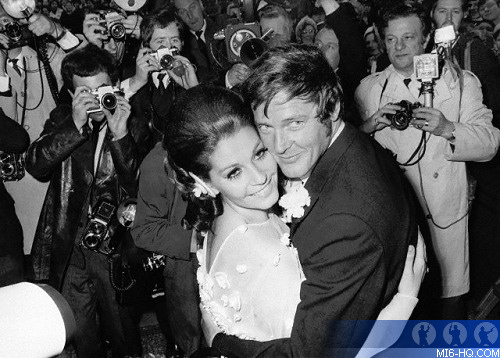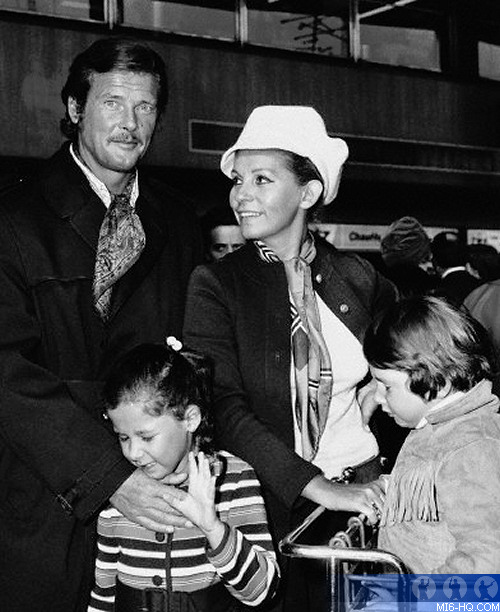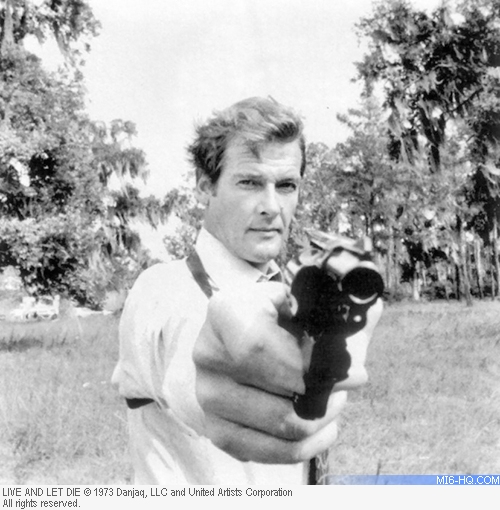Roger And His Wife
6th July 2013
Published 40 years ago this weekend, Roger Moore and his third wife Luisa talked to the US press to promote 'Live And Let Die'
 By MI6 Staff
By MI6 Staff
For a syndicated feature that headlined Sunday newspaper magazine supplements across the United States on July 1st, 1973, Roger Moore and his then wife Luisa talked about their lives and his rise to fame as the new 007.
Roger Moore and His Wife - He's the New James Bond
Will Roger
Moore follow in the money-minting footsteps of Sean Connery,
or in the slough of George Lazenby? That's the $7.5
million question United Artists is asking, because that's how
much "Live And Let Die" cost to produce. Saltzman and
Broccoli are so sure that More is "right" for James
Bond that they have signed him for two additional Bond pictures.
"I think," Roger Moore says, "that I've got an even-money chance to make it. After all, I've been around a long time in this business. I did 'The Saint' and TV for seven years then 'The Persuaders' on TV with Tony Curtis. And as a matter of fact, Cubby and Harry tell me that when they first started making the Bonders, I was their first choice for the role. I don't believe them, of course. But that's what they say."
Roger Moore is possibly the est-liked English actor in films today. He is alight-haired, blue-eyed, easygoing, down-to-earth man who has a kind word for everyone, even his two ex-wives. His current wife, the former Luisa Mattioli, an Italian actress, with home he lived for eight years and had two children before they could marry, describes him in her lilting Italian accents as "the most comfortable man, and actor - yes, but also a normal man, very calm, very good, reliable when the water gets rough."
The history of their relationship is by now well known here, which is why Luisa doesn't mind disclosing it.
|
"I met Roger," she explains, "in 1961 when we were filming together in Rome and Yugoslavia. It was after his Hollywood period - he had been unhappily under contract to MGM - and quite simply, we fell in love. He told his wife, Dorothy Squires, a very popular singer here, and like a decent, respectable man, he asked for a divorce. His wife said no. For eight years, this woman, this Dorothy Squires, would not divorce Roger. She is many years older than he is. She though his love for me was infatuation, that it would pass. And, of course, she was jealous. And I could understand that."
"She practiced - how you call it? - self-delusion. Even after out children were born, even after Roger and I set up house, she still would not divorce. It was very difficult for us. You can imagine. Difficult for me, for my family in Italy, for the children. And, of course, for Roger. No interviews. Nothing about his private life. No pictures of me, the children. Lies, whispers, gossips."
"I was living somewhere between heaven and hell, always under a cloud. After five, six years, I tell you the truth. 'She will never give you a divorce' I tell Roger. But he says, 'Don't give up hoping.' Then one day, November, 1968, Dorothy Squires - I never see her. We have never met. I see only her photo. One day she charges Roger with desertion, and she gets the divorce."
"I could not believe it. I think now it was because of her friends. They told her she was being silly, mean, revenge. What for? Roger was not coming back to her. Never. I think she realized that. Finally, Roger and I free to marry. Ho do you like that? After eight years living together and two children, free to marry. How do you like that? By then we were in no hurry. We wait until April, 1969. Then we marry in London. Now I am pregnant, for the first time in marriage. And it is, I must say, a relief. Because Roger and I are old-fashioned."
"Always we believed in marriage. I remember how I used to argue with my parents. You know how Italians are. If you compromise their daughter without marriage, they are ready to kill. I convinced my family not to harm Roger. I told them, 'He will marry me one day. Be patient.' I am sorry my father is not alive. He had a hotel in Genoa. He would enjoy our happiness and, yes, our luck."
"And we are lucky. We have this big, beautiful house, nine, ten bedrooms in Denham, 17 acres of land. And out two beautiful children, and another one on the way. And there is Roger's career. The new James Bond. I am sure he will be a success. He is a very professional actor. Everyone, everyone likes him, because he likes everyone. That is his secret. The good heart. No vinegar in his nature."
|
One reason Roger Moore is so well liked both in and out of the film business, is that he is basically and unpretentious man who refuses to take himself seriously, a welcome contrast to most actors.
"I'm really a lucky bloke," he admits, "who was born with a photogenic face and got a few lucky breaks. There was never any acting tradition in my family. My father, as you probably know, was a policeman here, and since I was his only child, we developed a really warm friendship. I grew up in South London, and despite the war I had a happy youth. My family never had much money, and I went to work after I left school for a company called Publicity Picture Productions, which specialized in animated cartoons."
"I started in as an apprentice cartoonist and was promptly fired, which in retrospect was one of those lucky breaks I mentioned."
Out of work, Moore was tipped by a friend that he might pick up a few pounds working as an extra in a film, "Caesar and Cleopatra", then shooting in Denham.
"I worked as an extra for a few days," he recalls, "and on the third days as I walked through the gates, a car pulled up alongside me. The co-director on the film was a man named Brian Desmond Hurst. He stuck his head out of the window, called me over, and asked if I was interested in becoming an actor. I said, 'Sure." Hurst told me that if I could get my family to support me for a while he would pay my tuition at the Royal Academy of Dramatic Arts. It sounds like a film script, doesn't it, but that's the truth of how I became an actor."
|
At drama school, Roger, because he was tall, handsome, and cheerful, attracted many girls, particularly a beautiful blonde named Doorn Van Steyn. When Moore was 18 he was called into the Army, commissioned a second lieutenant and shipped to a supply depot in postwar Germany. Two months after he reached 19, he applied for leave and married Doorn. They honeymooned in Germany where Moore remained on duty until he was almost 21. Discharged from the service, he returned to London to resume his acting career. But there were precious few jobs - at least for him.
"We lived with Doorn's sister in SOuthwest London," he narrates. "I worked as a dishwasher, a waiter, a male model. I did odd jobs in radio and TV. I even peddled novelties on Oxford Street. It was a rough five years, and gradually our marriage came apart. We were very young; we had very little money, very many bills, very many hardships. And we just fell out of love."
At a party in 1953 when Moore was almost 26 he met Dorothy Squires, then a big-name singer of 35, in London. They were mutually attracted, and before the year was out, Moore's wife was granted a divorce on grounds of adultery with Dorothy. That same year, however, Roger was screentested by MGM, signed to a screen contract starting at $250 a week and shipped off to Hollywood where his first film was "The Last Time I Saw Paris" with Elizabeth Taylor and Van Johnson. He also found time to marry Dorothy Squires in New Jersey and bring her out to Hollywood where they set up home.
Despite their age differential, Dorothy's subsequent four miscarriages, and Moore's inability to reach stardom at MGM, the marriage endured for eight years. Then Roger, convinced that he was being typecast in a series of MGM flops, became depressed, asked for his release and returned to Europe. In Rome to make "The Rape of the Sabines", he found that his co-star was Italian actress Luisa Mattioli. "As corny as it sounds," he says, "I think I fell in love with her at first sight. When Dorothy refused to give me a divorce, Luisa and I decided to live together."
As for Dorothy Squires, she once explained her reluctance to divorces Moore in these words: "I know I must have appeared stonyhearted in refusing so long to divorce him. But I had a big, big heartache I was carrying around with me. I was stubbornly determined that the woman who had taken Roger from me would never, never become his wife. But I guess time heals all wounds, and the bitterness fades with the years."
'I never expected Roger to be completely faithful. As handsome as he was the girls were always chasing him. BUt I simply blocked those thoughts from my mind. What one doesn't know doesn't hurt one. But I'm no longer hurt or bitter or filled with recrimination. I wish him the best of luck."
Roger Moore spent most of the 1960's starring in a TV series, 'The Saint'. "I devoted seven years of my life to it," he says, "and is was sold in 80 countries and is still being shown."
The series made Moore a millionaire, and he no longer needs to work if he doesn't want to. Last year, however, when producers Saltzman and Broccoli approached him with a multimillion-dollar offer to star in the next three James Bond thrillers, he couldn't refuse.
"It's not the money," he says, with a broad grin. "It's just that I've been wanting a role like this for the past 28 years."









